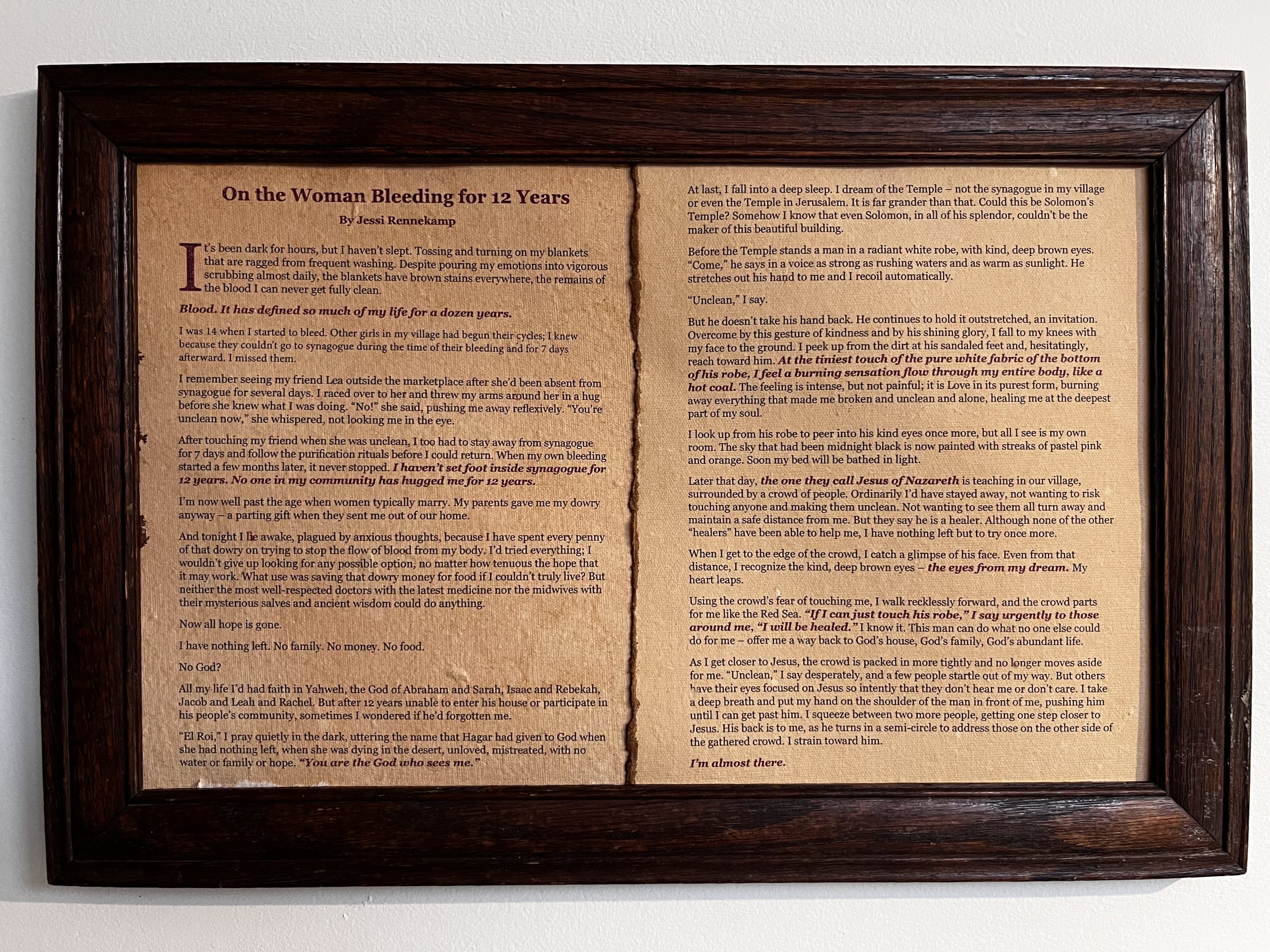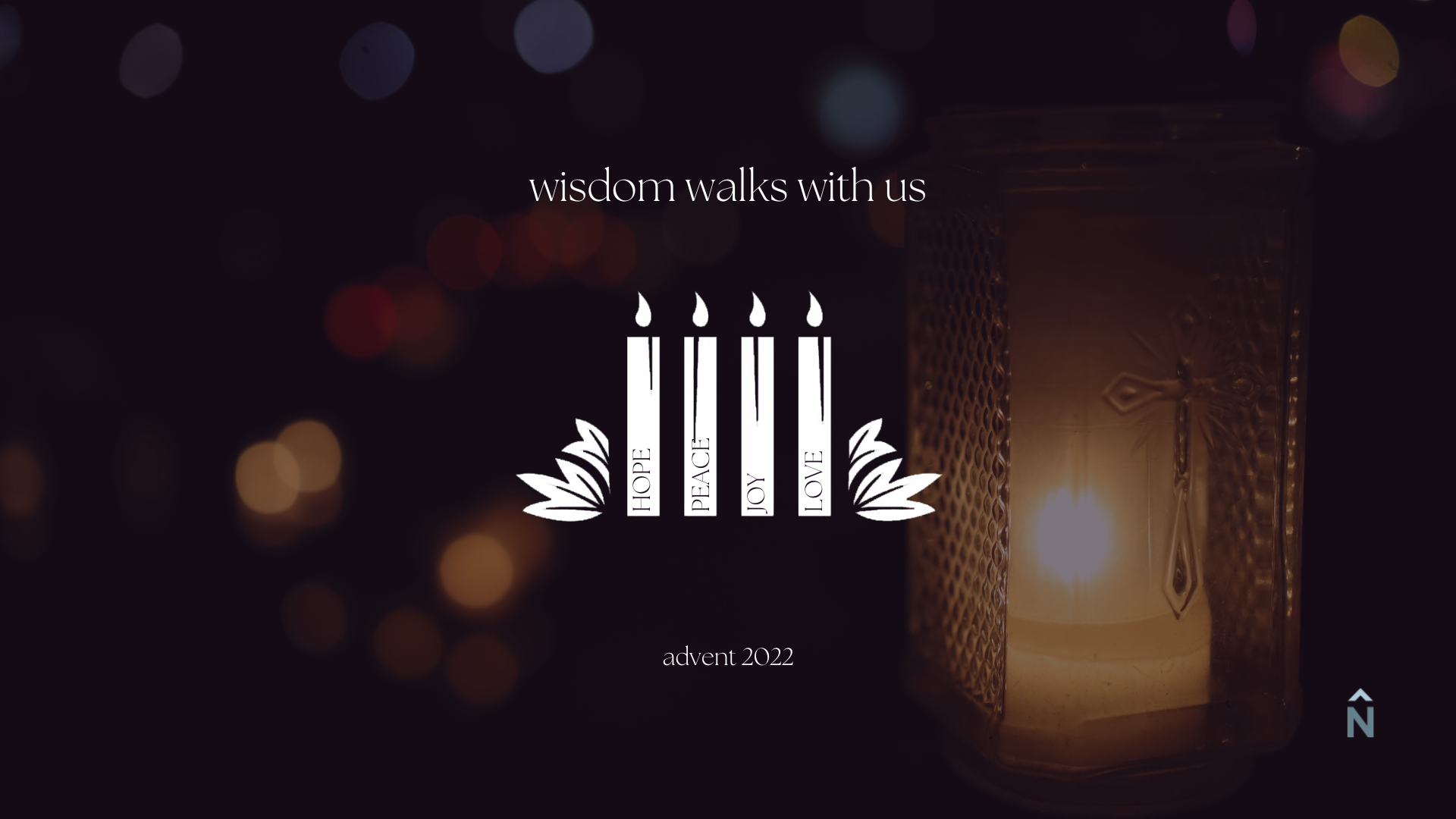About the Advent Devotional
The four weeks leading to Christmas are traditionally a season to anticipate Jesus’ arrival—to contemplate what it means for the God of the universe to be present with us.
This year’s Advent Guide builds on the Beautiful Life series by exploring the traditional Advent themes of hope, peace, joy, and love as wisdom walking with us. It meditates on moments when Jesus models the way of hope, the way of peace, the way of joy, and the way of love as paths to abundant life.
The gallery wall in the foyer of NSCBC displays narrative, paintings, sculpture, lyrics, and music by our very own artists. There you can pick up a printed copy of devotionals, contributed by our very own writers. NSCBC is richly blessed by the creative gifts of our people. Thank you to each one for inviting us to walk more in step with Jesus this Christmas. Your contributions are evidence that God’s Spirit indeed dwells with people.
Merry Christmas, dear friends!
Project Coordinators and Editors: Adam Kurihara, Sarah Bartley, Betsy Crowe
Click Here to Download the Full Devotional (PDF)
At some point in the last 50 years, Maslow’s Hierarchy leapt out of the world of social science and into public consciousness. We invoke that pyramid like a proverb, giving order to our otherwise tangled competition of motivations and needs. We imagine the pyramid—safety at the base and transcendence at the top—and conclude a meaningful life is available to us only when all other needs are satisfied.
We are tempted to believe that success will result in joy; that being excellent is more important than having hope; that certainty is the way to peace; and that comfort is a prerequisite for love. In the words of theologian Miroslav Volf, this is a recipe for a life that is unbearably light. Volf often looks to his parents—people who lived brave, intuitively virtuous lives in wartorn Yugoslavia—and finds an alternative proverb: all people can live a meaningful life.
At the very center of our faith is a person who we would consider impoverished: often lacking basic safety, affirmation, food, shelter, and friendship. Even so, Jesus lived a profoundly beautiful life. In the words of John, “his life is light for all of humanity.” Born in perilous times, to a marginalized family, yet Jesus is God’s wisdom in flesh and bone, dwelling among us. And he offers to walk with us, showing us the way to full, abundant life.
As this year comes to a close, we invite you to set aside some time for reflection. Read the gospel passages and meditations. Visit the gallery at church. They explore hope, peace, joy, and love not as nice additions to an already full life, but as beautiful ways to live. Look not only inward, but outward. They urge us to walk with Jesus in the way of hope, in the way of peace, in the way of joy, and in the way of love.
What does the way of love look like? Jesus graciously shows us. Out of his fullness—his abundant life—he offers us “grace upon grace.” To be wise in love, we cannot stop at simply experiencing love. That would be too sentimental a view of love! We can look at the world around us and notice the urgency of love. We can learn the tactics of love. We can practice them at work and at home, at church and in public.
The same is true of peace, hope and joy. When we practice the way, we find that the Source of infinite love and peace and hope and joy indeed dwells with us already. May the meditations and encouragement of your brothers and sisters in this Advent Guide help you do just that—and may the light of Jesus’ life illuminate your way.
Art for Week 1
Advent 2022 | Sarah Bartley
Sculpture using communion cups, spray paint, wreath materials
Artists Statement: As church regathered, pre-made communion cups offered a sanitary solution to the communal passing of bread and wine. Sitting in the pew, cup in hand, I imagined giving it another life of some kind—redeeming it—resisting the single-use, transactional way of being that feels more at home in America than at Jesus’ Table. Afterall, these cups participated in a sacred ritual. Each one had been held at the Lord’s Table. Could they be made to fit together? Could their hard edges and angles align? (Not easily.) Could they be fashioned into a new form? Might that new form catch the light? At the Lord’s Table, Jesus tells his disciples to remember—remember his life until he dwells with them again. Remember his Table. Remember the joy, the peace, the hope, and the love they experienced—that was required of them—to gather at Jesus’ Table. They gathered across social dividing lines: marginalized and powerful, rich and poor, outsiders and insiders. At the Lord’s Table we find our posture. We are eye to eye, arm to arm. We feast and we remember. We are no longer lone individuals. We are fashioned into a new shape. Love, joy, peace, and hope are available in abundance when we do Table fellowship (Jesus style). These are some of the ideas I was considering as I gave new life to the communion cups we shared during 2022.
– Sarah Bartley
Short Story | On the Woman Bleeding for 12 Years | Jessi Rennekamp
Narrative on handmade paper

Artists’ Statement: I have recently become interested in the practice of meditating on Scripture by writing fictionalized accounts of biblical stories that explore the characters’ internal thoughts, feelings, and backstories, that dive into the intentional “gaps” in the biblical narrative and fill in possible details, and that elucidate the significance of the text in a way that helps modern readers connect it to their lives in a new way. Jewish rabbis have created stories like this as part of a collection of writings designed to interpret and apply the Torah, known as “midrash.” I’ve been engaged by Christian midrash-like stories, including The Chosen TV series, the “creative writing” chapters of Inspired by Rachel Held Evans, and certain poems in Madeleine L’Engle’s The Ordering of Love.
When I began reflecting on the theme of hope, the first image that came to my mind was of the times that I’ve been anxiously awake in the wee hours of the morning, with my thoughts and fears and feelings of hopelessness keeping me tossing and turning in my bed. Sometimes, on those nights, I’ve turned to Jesus in prayer and found a hope that surpassed my circumstances; a hope that let me drift off to sleep and awake to new light – and his new mercies – the next morning. I started to imagine that the woman who had been bleeding for 12 years may have had nights like that. For her, Jesus was her last hope as she’d spent everything she had on solutions that didn’t work. So I chose to write about an imagined night of hopelessness that turned to hope, and those moments of ever-increasing hope as she drew closer to Jesus.
I pray that her story of hope for healing and for restored relationships with God and community may resonate in a new way with each of us this Advent season.
– Jessi Rennekamp
Devotionals
Monday November 28 | The Way of Hope | Matthew 5:2-12
Andrew Rennekamp
Ever wish you didn’t know something? A phone call that ruined a good day. An unwanted exposure to darkness or terror. Or perhaps simply the knowledge that something is not as good as it could be.
This is the hard truth of Ecclesiastes: “wisdom brings vexation, and with knowledge comes sorrow” (Eccl.1:18). Or in our contemporary converse: “ignorance is bliss.” To paraphrase much of Ecclesiastes, “How is a life of wisdom beautiful at all?”
I’ve wrestled with this question myself. I’m fortunate enough that I could choose to ignore the troubling reality of the world around me, my head emersed above it all, and imagine to myself everything is beautiful. Or, I can live immersed in (and often dwelling on) the poverty, injustice, foolishness, and evil in the world around me and be a… well, let’s just say… less than beautiful person to talk to. Steve’s song brilliantly captures this experience—of fumbling through fog and of growing rust.
Ecclesiastes offers a prescription for those who choose the path of wisdom: “Fear God and keep his commandments, for this is the duty of humanity. For God will bring every deed into judgment, with every secret thing, whether good or evil” (Eccl. 12:13-14). Within this prescription there is a glimmer of HOPE. Ultimately, God will make every deed known and finally bring about justice.
But if you, like me, don’t feel all that hopeful reading these words, it’s because there’s also a strict warning woven in here. If we do not keep God’s commands, we too will be judged. I really HOPE I don’t screw up.
Within the context of this seedling of HOPE enters The Wisdom of God personified—Jesus (1 Cor. 1:24). Remarkably, Jesus upholds the Ecclesiastes prescription, saying “don’t think that I’ve come to overturn the commandments of God… whoever does them and teaches them will be called great in the kingdom of heaven” (Matt. 5:17-20) and “on the day of judgment people will give an account” (Matt. 12:36). But he does more than that. In his Sermon on the Mount in particular, Jesus expands this glimmer of HOPE.
He doesn’t ignore the reality of the mess around him or complain about it. Instead, Jesus names eight types of people immersed in the reality of our fallen world and pronounces unexpected blessing on them. Paraphrased, Jesus says, “Blessed are those aware of their need, for they will be satisfied” intentionally woven together with “Blessed are those reflecting God’s character, for they will meet God himself” (Matt 5:2-12).
The wisdom of God revealed to us through Christ is that God is not only the one who will bring every deed into judgment, but he is also the one who saves. God himself, though righteous and pure, is gentle and merciful, a peacemaker who became poor of spirit, hungry, and hated so that we could be filled.
A life of wisdom is beautiful when its HOPE is in God’s rescue.
After pronouncing blessings on the poor, hungry, grieving, and hated, Jesus gave four warnings for the complacent (Luke 6:24–26), who believe they have no need for him. In contrast, his message of HOPE was delivered to those most aware of their need for him, including many who were physically ill (Matt. 4). It’s these people—who shed tears, yet also HOPE in the knowledge of God’s rescue and share it with others—who Jesus would go on to call “salt” and “light” (Matt. 5:13).
Take a few minutes to pray along with me. LORD, hear our prayer. Search our hearts and help us to reject complacency. Instead teach us to embrace Wisdom, in all her joy and grief. By your Spirit strengthen our desire to keep your commands and remind us of the HOPE we have in you. Thank you for your Son, who leads us into your Kingdom, where you satisfy us with yourself and where all that is wrong is set right and made new. Help us to live out wisdom beautifully, as salt and light, sharing the HOPE we have with those around us. Amen.
Wednesday November 30 | The Way of Hope | John 11:17-44
Porter Sprigg
“Take away the stone,” he said.
“But, Lord,” said Martha, the sister of the dead man, “by this time there is a bad odor, for he has been there four days.”
Jesus approaches the tomb of Lazarus, knowing what is going to happen. New life is going to spring from a place of mourning and death. But first, the stone must be rolled away. Martha protests. No one wants to smell death, especially if the body is your brother’s. Martha doesn’t want to face the smell. To do so would be disgusting and heartbreaking.
There are some things in our lives that we just don’t want to uncover. We are ashamed of what we’ve done or how we’ve treated others. We are crushed by the ways we’ve been abandoned or mistreated by others, and we hide these things from God because we are afraid to face the decay and pain. We assume that it will disgust God the same way it disgusts us.
When God tells us to roll away the layers of stone in our hearts, to reveal our inner woundedness and sin, we protest. But in the very places where we feel dead and dismayed, God wants to heal. Where we recoil in the face of decay and want to run from our sin and our pain, God moves towards us in compassion.
God wants to show up in the places you feel most lonely, most angry, most hurt. Why? Look earlier in the passage:
“’Where have you laid him?’ He asked. ‘Come and see, Lord,’ they replied. Jesus wept. Then some of the Jews said, ’See how he loved him!’” Jesus sees the decay in your life and he responds with tears and compassion because He loves you! He is committed to you with a commitment that transcends understanding and he is willing to do whatever it takes to resurrect your life with that steadfast love.
In his book, Gentle and Lowly, Dane Ortlund writes, “The sins of those who belong to God open the floodgates of his heart of compassion for us. The dam breaks. It is not our loveliness that wins his love. It is our unloveliness.” Our decay, our sin draws Jesus near. That may not make sense. It may seem completely wrong, but we have to let Jesus love us on his terms. Jesus compassionately moves toward the decay.
This reality should fill us with humility and hope. If Jesus loves us in the midst of our decay, if he died for us “while we were still sinners,” then there is no room for boasting. But there is also no room for despair. Christ brings freedom to the weary sinner. The smell of death isn’t the end of the story. Jesus commands Lazarus to come out of the grave and he does! Hallelujah! Jesus resurrected Lazarus and he’ll resurrect you.
The Archbishop Desmond Tutu, a leading voice in the racial reconciliation movement in South Africa, encountered horrid racism in his life. Tutu was known for his contagious joy and laughter.
Towards the end of his life when Tutu was battling cancer, a cynical American reporter interviewed him and asked how he could be so joyful. The reporter pointed to the ways that South Africa had taken steps backward in terms of justice and asked directly, “How can you be so joyful when you’re about to die and your country is still so fundamentally broken?” Desmond lit up with a grin on his face, tapped his clerical collar to remind the reporter of his faith and said, “Ah you forget. We are resurrection people.” What a profound answer. We are resurrection people! Desmond knew that the power of death would not have the final say on his life because of Jesus’ resurrection power and he also knew that even the darkest places can be transformed by God’s light. May we be people who let God into our own brokenness and then move with compassion towards the decaying corners of our world!
Friday December 2 | The Way of Hope | Luke 2:25-38
Karoline Niles
In this cultural moment, hope can be perceived as overrated and even unhelpful. After high profile instances of abuse and corruption, this is understandable—it is important to be honest and realistic. And yet, it is impossible to construct a better world without hope. How do we help one another do better unless we have hope that better is possible? How do we build a business or help a student through a crisis without hope? Biblical hope is like that—it has to do with our capacity to imagine a different future because we trust in the character of God to be who He says He is and do what He says He will do. Hope involves training our expectations to see the potential that God sees.
Luke drops in on a remarkable moment at the end of two long, faithful lives. We know that Simeon lived a devout life in prayerful expectancy and Anna worshiped night and day at the temple. At some point in his life, Simeon was given a promise that he would see God’s Messiah. He would meet the fulfillment of God’s promise. Both lived out days filled with ordinary moments, in relational rhythms with God and with the community of God’s people, at the temple engaged with God’s Spirit. It must have required discipline to hold on to hope as Simeon aged. It would be understandable if he had moments of doubt.
How do we cultivate hope? The relational rhythms of worship and community prepared Simeon and Anna to recognize Jesus—this specific baby born to these specific parents—as the child of God’s promise. I worked landscaping and property maintenance on an estate for about three years. Manual labor outside in the hot, humid weather would have been grueling but for the consistent breaks we took together. Each day our boss sent a text at nine o’clock for coffee time, noon for lunch, and three o’clock for tea time. At any given moment, a break was never more than a few hours away. I could do just about any job for that amount of time knowing there was good coffee and good conversation waiting. These were the relational rhythms that sustained me.
Simeon and Anna did not know how or when God would fulfill his promise. Yet their lives were undoubtedly shaped by actively expecting it. A lifetime meditating on Scripture with the community of God’s people prepared them. When Jesus did arrive, they recognized him. They rightly perceived this child as the great climax of hope realized and still yet only just beginning to set the world right. As you reflect on this passage, take some time to consider the rhythms that prepared Simeon and Anna to recognize Jesus. What do you think it was about Jesus and his parents that alerted Simeon and Anna that this was the Messiah they hoped for? Consider the rhythms that are cultivating your capacity for hope. Consider the places and relationships where God may be calling you to exercise hope.
What do we do when we don’t know when tea time is coming? How do we continue to work in the meantime? This week, as you meditate on hope, consider reading Isaiah 40 each morning and ask God “What may I hope for?” Simeon and Anna likely asked God this very question. God told them they may hope for a Messiah. Like Simeon and Anna, ask God your questions about hope and live expectantly for Emmanuel: God with us.





